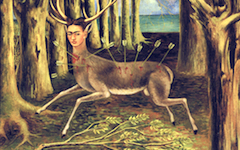Kahlo’s Self-Portrait with Portrait of Dr. Farill (1951)
Everyone agrees that Frida Kahlo's art is highly biographical and an investigation of her psyche but now that we know that many great masters also painted their own inner quest for the perfect masterpiece we are left with a question: is the underlying meaning of Kahlo's art mainly a variation on Surrealism and the folk art of Latin America, as conventionally believed, or was she perhaps influenced to an equal extent by the traditional canon like any other great poetic painter? Much of her art has been interpreted as a depiction of her psychological state during her long, tempestuous relationship with Diego Rivera. Even when Rivera's figure does not appear in a painting experts have a tendency to identify other features as a symbol of her partner's presence. That method, however, does not work well on a late painting, Self-Portrait with Dr. Farill, and suggests that even Kahlo's pictures of Rivera need rethinking.

Kahlo, Self-Portrait with Dr. Farill (1951) Oil on canvas. Private Collection.
Click image to enlarge.
Frida, contrary to popular belief, did not actually have a unibrow. She had heavy eyebrows which in her paintings she joined into one, perhaps initially to express an androgynous mind. It is striking then that Dr. Farill, who also had normal eyebrows, gains a unified one in her portrait. He has become her, an alter ego of the artist, and another means of expressing the androgyny of her creative spirit.
Not only does he become like her but she becomes like him. As others have noted, her folk costume has been simplified and altered to resemble a physician's white coat.1 Each figure has thus taken on an aspect of the other though they are both her. Her diary confirms her identification with the doctor who, like her, continued work hard, caring for the sick, while seriously ill himself.
See conclusion below
Doctors, particularly surgeons, have often been significant figures for artists, from Rembrandt to Thomas Eakins and Lucian Freud. The hands of surgeons explore the human body in order to return a patient to health while also prolonging and improving their lives. Artists, in a somewhat similar vein metaphorically, are doctors of the soul, helping through their art to guide the perceptive minds of individual viewers to a greater understanding of the human spirit. And, like surgeons, they use their hands to manipulate the human figure as well, using paint in place of flesh and blood. For that reason, perhaps, Kahlo's palette is a human heart. And we have demonstrated elsewhere how war and battles are often symbols for an artist's struggle to create with blood as symbol for paint.
Frida Kahlo, it seems, may have had more in common with the great masters of the Western tradition than previously recognized.
More Works by Kahlo
Notes:
Original Publication Date on EPPH: 30 Oct 2010. | Updated: 0. © Simon Abrahams. Articles on this site are the copyright of Simon Abrahams. To use copyrighted material in print or other media for purposes beyond 'fair use', you must obtain permission from the copyright owner. Websites may link to this page without permission (please do) but may not reproduce the material on their own site without crediting Simon Abrahams and EPPH.


